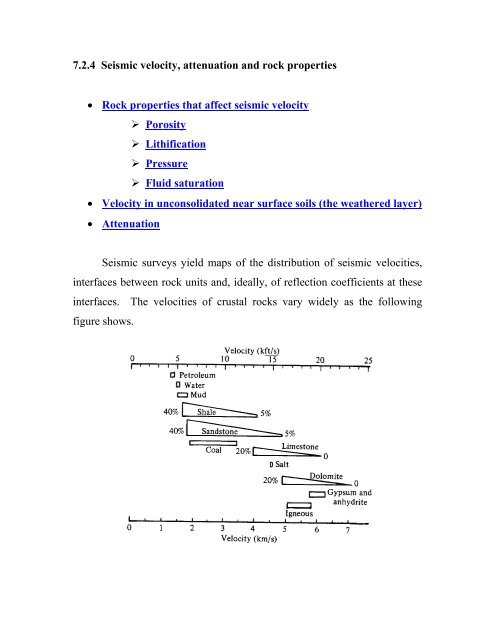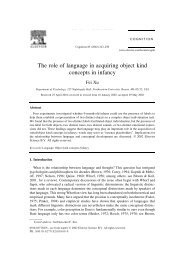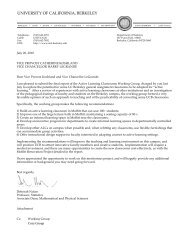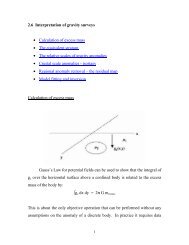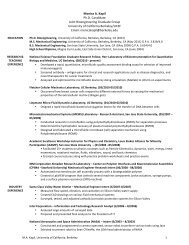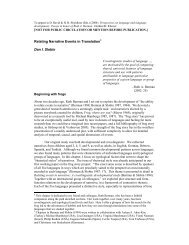Seismic velocity and rock properties
Seismic velocity and rock properties
Seismic velocity and rock properties
Create successful ePaper yourself
Turn your PDF publications into a flip-book with our unique Google optimized e-Paper software.
via:Generally, the velocities depend on the elastic modulii <strong>and</strong> densityµ= K + 4V 3P<strong>and</strong>ρV S=µρThese elastic constants, <strong>and</strong> densities, in turn depend on the <strong>properties</strong> thatthe geologist or engineer use to characterize the <strong>rock</strong> such as porosity, fluidsaturation, texture etc. A review of the relationships between the intrinsic<strong>rock</strong> <strong>properties</strong> <strong>and</strong> the measured velocities or reflectivities is needed beforeseismic survey results can be interpreted quantitatively in terms of lithology.Many of these relationships are empirical – velocities are found to be relatedto certain <strong>rock</strong> units in a given locale by actual laboratory measurements oncore samples of the <strong>rock</strong> or soil.It is observed from seismic surveys that velocities generally increasewith depth. Densities also increase with depth so it must be that the bulk<strong>and</strong> shear modulii increase faster than the density. In seismic explorationthere are many empirical relationships between <strong>velocity</strong> <strong>and</strong> depth of burial<strong>and</strong> geologic age.The relationship between intrinsic <strong>rock</strong> <strong>properties</strong> such as porosity,fracture content, fluid content <strong>and</strong> density <strong>and</strong> <strong>velocity</strong> underlie theempirical relationships mentioned above.
Rock <strong>properties</strong> that affect seismic <strong>velocity</strong>1) Porosity.A very rough rule due to Wyllie is the so called time averagerelationship:1 φ 1 − φ= +Vbulk V fluid Vmatrixwhere φ is the porosity.This is not based on any convincing theory but is roughly right when theeffective pressure is high <strong>and</strong> the <strong>rock</strong> is fully saturated.2) Lithification.Also known as cementation. The degree to which grains in asedimentary <strong>rock</strong> are cemented together by post depositional, usuallychemical, processes, has a strong effect on the modulii. By filling porespace with minerals of higher density than the fluid it replaces the bulkdensity is also increased. The combination of porosity reduction <strong>and</strong>lithification causes the observed increase of <strong>velocity</strong> with depth of burial <strong>and</strong>age.3) Pressure.Compressional wave <strong>velocity</strong> is strongly dependant on effectivestress. [For a <strong>rock</strong> buried in the earth the confining pressure is the pressure
of the overlying <strong>rock</strong> column, the pore water pressure may be the hydrostaticpressure if there is connected porosity to the surface or it may be greater orless than hydrostatic. The effective pressure is the difference between theconfining <strong>and</strong> pore pressure.]In general <strong>velocity</strong> rises with increasing confining pressure <strong>and</strong> thenlevels off to a “terminal <strong>velocity</strong>” when the effective pressure is high. Theeffect is probably due to crack closure. At low effective pressure cracks areopen <strong>and</strong> easily closed with an increase in stress (large strain for lowincrease in stress—small K <strong>and</strong> low <strong>velocity</strong>). As the effective pressureincreases the cracks are all closed, K goes up <strong>and</strong> the <strong>velocity</strong> increases.Finally even at depth, as the pore pressure increases abovehydrostatic, the effective pressure decreases as does the <strong>velocity</strong>.Overpressured zones can be detected in a sedimentary sequence by theiranomalously low velocities.4) Fluid saturation.From theoretical <strong>and</strong> empirical studies it is found that thecompressional wave <strong>velocity</strong> decreases with decreasing fluid saturation. Asthe fraction of gas in the pores increases, K <strong>and</strong> hence <strong>velocity</strong> decreases.Less intuitive is the fact that V s also decreases with an increase in gascontent. The reflection coefficient is strongly affected if one of thecontacting media is gas saturated because the impedance is lowered by boththe density <strong>and</strong> <strong>velocity</strong> decreases.
Velocity in unconsolidated near surface soils (the weathered layer)The effects of high porosity, less than 100% water saturation, lack ofcementation, low effective pressure <strong>and</strong> the low bulk modulus (due to theease with which native minerals can be rearranged under stress) combine toyield very low compressional <strong>and</strong> shear wave velocities in the weatheredlayer. V p can be as low as 200 m/sec in the unsaturated zone (vadose zone)– less that the <strong>velocity</strong> of sound in air!AttenuationIt is observed that seismic waves decrease in amplitude due tospherical spreading <strong>and</strong> due to mechanical or other loss mechanisms in the<strong>rock</strong> units that the wave passes through.The attenuation for a sinusoidal propagating wave is defined formallyas the energy loss per cycle (wave length) ∆ E/E where E is the energycontent of the wave.Mathematically, the propagating wavedamping terme −αxso the solution becomesA = A eiωt−ikxe−αx0A =A eiωt−ikx0 , get an added
[We can apply this to the definition of attenuation ∆ E/E by substituting A 2for the energy at two points at distance λ (the wavelength) apart <strong>and</strong> we find∆EE= 2αλ .]There are many theories for explaining attenuation in <strong>rock</strong>s. Friction,included by including a <strong>velocity</strong> term in the governing differential equationfor the displacement does not explain laboratory measurement. Variousother damping mechanisms such as viscous flow (Biot Theory) have somesuccess but much important work remains to be done in this area (especiallyfor unconsolidated material where the attenuation is very high). Some of thetheories predict attenuation as well as dispersion (the variation of <strong>velocity</strong>with frequency).Experimentally it is found that the attenuation coefficient α dependson frequency <strong>and</strong> that there is little dispersion. In fact to a goodapproximation attenuation can be described byAA e−βfx= 0 . With x inmeters <strong>and</strong> f in Hertz, a typical shale has a β = 10 -4 . So at one Hertz theamplitude falls to A 0 /e at 10 km. But at 1000 Hz it falls to A 0 /e in 10 m.The attenuation may be as much as 10 times greater in unconsolidatedsediments.Another important attenuation mechanism is the reduction inamplitude of a wave by the scattering of its energy by diffraction by objectswhose dimensions are on the order of the wavelength. If a is an averagelinear dimension of <strong>velocity</strong> inhomogeneities then the attenuation coefficientis given approximately by:
a3α ≈λ4So attenuation increases rapidly with decreasing wavelength. Considerattenuation is an unconsolidated medium with a <strong>velocity</strong> of 250 m/sec <strong>and</strong> afrequency of 1000 Hz. Then, λ = 0.25 m, <strong>and</strong> α = a 3 ×256. The wave wouldfall to 1/e of its initial amplitude when a = 157 m.It might be reasonable to expect inhomogeneities with a characteristicdimension on the order of 15 cm in the overburden so it is likely that thevery high attenuation observed in near surface unconsolidated sediments isdue to scattering.


